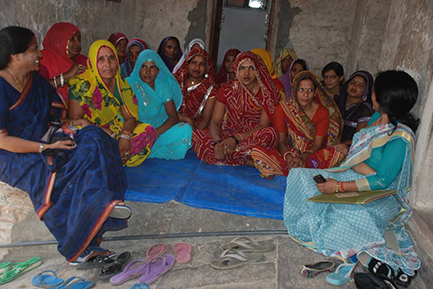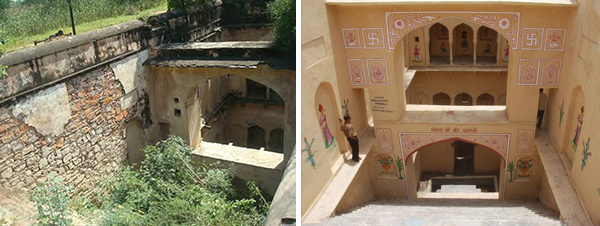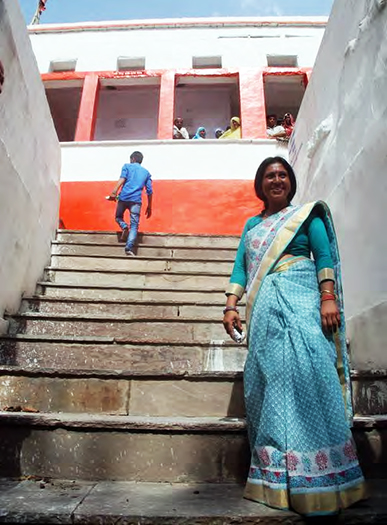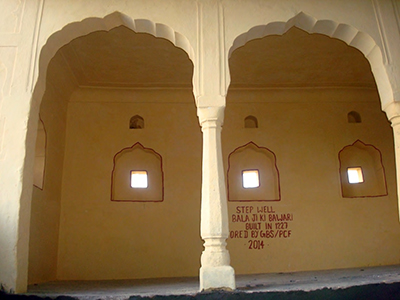Global Heritage Fund and its NGO partners Prince Claus Fund and Gram Bharati Samiti have carried out an investigation on how to address threats to the Stepwells of Rajasthan, India. A series of local Stepwells have been restored, and GHF is looking forward to continuing its involvement with much-needed architectural expertise.
Funded by an initial grant, restoration was carried out on 5 Stepwells:
1. Bagichiwali Baoli, Bhanpur
2. Banjaron ki Baoli, Thali
3. Bohraji ki Baoli, Khawarani
4. Meeno ki Baoli, Sarjoli
5. Balaji ki Baoli, Bhanpur
1. Bagichiwali Baoli, Bhanpur

A Village women’s committee has been formed to look after the restored step wells.
Bagichiwali Baoli was built in 1625. There, villagers perform social and religious rituals at a big enclosure attached to the Stepwell. There is a temple were they conduct prayer rituals with the water that they collect. There is also a tank outside the Stepwell that provides surrounding birds and animals with water.
Key conservation highlights:
• Created public health facilities like washing and bathing platforms for men and women.
• The overflow of the village’s water tank has been set up to move through an underground tube in order to recharge the Stepwell during non-monsoon season.
• The Stepwell has been cleaned out, cracks in the walls have been filled, and the structure’s surfaces have been painted over under the direction of a local artist, who reintroduced traditional folk motifs such as musicians, which symbolize festivity.
• A central part of the restoration process was the participation of local villagers – women, in particular. A women’s committee was formed to look after the newly restored Stepwell to ensure its upkeep.
The restoration work has significantly improved the quality, status and the dignity of the structure, functionally and spiritually. A halt in littering and other abuses demonstrates a change in sentiment toward the structure. Bagichiwali is now integrated with other community facilities, and its restoration has raised awareness and produced improvements in hygiene and sanitation.
2. Banjaron ki Baoli, Thali

Stepwell after restoration
Banjaron ki Baoli, built in 1012, is believed to have been constructed by Lakhi Banjara, the well-known leader of a nomadic tribe, out of a nearby village’s white stone and no supporting material. It was the only source of water for the people of Thali, who performed all prayer rituals from birth to death near the Stepwell after bathing in it. The elaborate structure is significant architecturally and aesthetically.
Key conservation highlights:
• Cleaning out debris that has accumulated over decades, digging within the well’s mouth
• Physically repairing broken structures (wall, column, bracket, eaves, steps, floor, etc.) and replacing missing components
• Wall paintings by a regional painter depicting traditional motifs
The restoration work has strongly improved the quality, status and dignity of the structure, functionally and spiritually. These changes have deterred littering and abuse to the structure, and it is once again a vital part of the villagers’ daily routine as a civic venue, largely through spiritual significance.
3. Bohraji ki Baoli, Khawarani

Left: Stepwell before restoration. Right: Stepwell after restoration
According to legend, Bohraji ki Baoli was built by a man named Deenaramji Bohara on the insistence of his wife in 1510. Its water was used for drinking, irrigation and worship, including numerous cultural and religious events each year such as the annual Goddess Jobner Mataji event, where thousands of visitors bathed and worshipped the Goddess in the Bohraji temple.
Key conservation highlights:
• Common amenities such as a temple, a community hall, washing and bathing areas have reignited the venue as a collective civic center for the village
• Restoration development has been carried out through the villagers’ active participation
• The subterranean flow of water has been activated, recharging the Stepwell and re-establishing its sacred status
• A local artist has underlined the regional flavor through popular folk motifs in wall paintings such as guardians, dancers, elephants and camels, intensifying cultural associations and regional identity
Thanks to the restoration work, the structure is now respected and revered. Its integration with other community facilities and public health utilities in the area has been a key force in its increasing value to the village’s community members.
4. Meeno ki Baoli, Sarjoli

Meeno ki Baoli is an established pilgrimage centre
Meeno ki Baoli is an established pilgrimage centre, built in 573, strategically in the Sarjoli village, which has a population of nine thousand and serves as a popular pilgrimage destination due to its housing of the Sati Mata Shrine and the Saint’s Memorial. The bulk of visitors come to Sarjoli on Tuesdays and Saturdays, often staying in the centrally located dormitories. Meeno ki Baoli is not known for its architectural character or aesthetic appeal, but it is tremendously significant as the backdrop for traditional religious rituals.
Key conservation highlights:
• Community facilities have been developed such as washing and bathing platforms for men and women, a drinking water tank and a protective gate for the compound
• The Stepwell has been cleaned out, the water fetching system has been facilitated, cracks in the walls have been filled, and the surfaces has been painted over
• The subterranean water flow has been reactivated
• Restoration work was carried out through the direct participation of the “Shrine” or “Religious” Trust, who have been very supportive and excited to take over the site’s maintenance
The structure’s enhancement has deepened the spiritual bond between community members and the village. Ceremonies and rituals associated with water have been reinstated, and the Stepwell’s integration as an important spiritual landmark has intensified the significance of the religious Mecca, Sarjoli.
5. Balaji Ki Baoli, Bhanpur

Stepwell after restoration.
Balaji ki Baoli was constructed in 1227, and was the area’s only potable water source. At first, it was built as a temple and then developed as a Stepwell; it contains unique architectural characteristics such as a mezzanine floor
Key conservation highlights:
• Work at the structure consisted of cleaning, digging, repairing and plastering of the Stepwell’s walls
• A sustainable mechanism for retaining a tree within the structure has been created, especially significant because it is considered sacred by the local community
• In addition to the modest motifs painted by a local artist, a symbolic deity has been installed, enhancing the building’s ceremonial appeal
Our conservation work as unlocked the structure’s potential to again become a community center with accommodations for performing worship rituals such as sacrificial fire offerings, locally known as hawan.
Photos for report provided by: Gram Bharati Samiti (GBS)

